Confidence Interval of a Proportion#
Introduction#
Welcome to the chapter on the Confidence Interval of a Proportion. This is a fundamental concept in biostatistics that allows us to estimate the range within which a population parameter lies, based on our sample data.
Definitions#
What is a Confidence Interval?#
A confidence interval is a range of values, derived from a data set, that is likely to contain the value of an unknown population parameter. It provides an estimated range of values which is likely to include an unknown population parameter, the estimated range being calculated from a given set of sample data.
What is a proportion?#
In statistics, a proportion refers to the fraction of the total that carries a certain characteristic. For example, if we have a sample of 100 individuals and 45 of them are female, the proportion of females in the sample is \(45/100 = 0.45\).
Confidence interval of a proportion#
When we talk about the confidence interval of a proportion, we’re trying to find a range that likely contains the true proportion of the population that carries a certain characteristic. This is based on the proportion we’ve found in our sample.
In this chapter, we will learn how to calculate the confidence interval of a proportion using Python with the numpy and scipy.stats packages. We will also discuss the interpretation of confidence intervals, the impact of sample size on the confidence interval, and common misconceptions about confidence intervals.
Binomial distribution#
The Binomial Distribution is a crucial concept in statistics and probability theory that describes the number of successes in a sequence of independent experiments.
A binomial distribution can be thought of as simply the probability of a SUCCESS or FAILURE outcome in an experiment or survey that is repeated multiple times. The binomial is a type of distribution that has two possible outcomes (the prefix ‘bi’ means two, or twice).
Single coin flip#
When we flip a coin once, there are two possible outcomes: heads (H) or tails (T). If the coin is fair, the probability of getting heads \(P(H)\) is 0.5, and the probability of getting tails \(P(T)\) is also 0.5. This is because a fair coin is equally likely to land on either side.
This scenario can be modeled as a binomial distribution with parameters n=1 (number of trials) and p=0.5 (probability of success on each trial). In this case, a “success” could be defined as getting heads. Here’s how we can simulate a single coin flip in Python:
import numpy as np
n = 1 # number of coin flips
p = 0.5 # probability of getting heads
# Simulate a single coin flip
flip_result = np.random.binomial(n, p)
# Check the result
if flip_result == 1:
print("Heads")
else:
print("Tails")
Tails
In this script, np.random.binomial(n, p) generates a random number that follows a binomial distribution. It returns the number of successes (heads, in this case), which can be either 0 or 1 for a single coin flip. Although we can calculate the probabilities exactly for a single coin flip, real-world phenomena often involve more complex situations with multiple trials, which is where the binomial distribution becomes truly useful.
Multiple coin flips#
Let’s now simulate 10,000 experiments of flipping a coin 10 times each, calculates the mean number of heads across all experiments, and visualize the results.
# Parameters of the binomial distribution
n = 10 # number of coin flips per experiment
p = 0.5 # probability of getting heads
np.random.seed(111) # for reproducibility
# Number of experiments
num_experiments = 10000
# Simulate the experiments
experiments = np.random.binomial(n, p, num_experiments)
# Calculate the mean number of heads
mean_heads = np.mean(experiments)
print(f"Mean number of heads out of 10 flips in {num_experiments} experiments: {mean_heads}")
Mean number of heads out of 10 flips in 10000 experiments: 5.0224
The experiments array contains 10,000 values ranging from 0 to 10, with the mean number showed above. Let’s plot a histogram to visualize the distribution of the number of heads in these experiments.
import matplotlib.pyplot as plt
plt.hist(
experiments,
bins=range(n+2),
align='left',
rwidth=0.8,
color='orangered',
edgecolor='black',
)
plt.xlabel('Number of Heads')
plt.xticks(np.arange(0, 11, 1))
plt.ylabel('Frequency')
plt.title('Histogram of heads in 10,000 coin flip experiments');
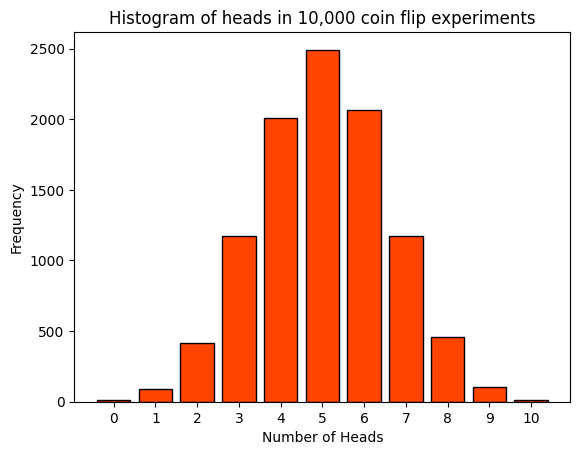
A histogram is a graphical representation that organizes a group of data points into a specified range. In this case, the data points are the number of heads obtained in each of the 10,000 experiments of flipping a coin 10 times. The x-axis represents the number of heads obtained in each experiment, which can range from 0 to 10. The y-axis represents the frequency, i.e., the number of experiments that resulted in a certain number of heads. Each bar in the histogram corresponds to the number of heads (from 0 to 10). The height of each bar represents the number of experiments that resulted in that many heads.
For a fair coin, we would expect the most common outcome to be around 5 heads, so the tallest bar should be around the middle of the histogram. This is because the binomial distribution is symmetric for a fair coin (\(p=0.5\)).
In summary, the histogram provides a visual representation of the distribution of outcomes over many repeated experiments, and it should reflect the properties of the binomial distribution given a large enough number of experiments. It’s a great way to intuitively understand the concept of a binomial distribution. Happy learning!
Probability and frequency#
Probability is a statistical measure that shows the likelihood of an event to happen. It is quantified as a number between 0 and 1, where 0 indicates that the event will not happen and 1 indicates that the event will definitely happen. In our coin flipping experiment, the probability of getting heads (or tails) in a single flip of a fair coin is 0.5, meaning there’s a 50% chance we’ll get heads (or tails).
Frequency, on the other hand, is a measure of the number of times an event occurs. For example, if we flip a coin 10 times and get heads 7 times, the frequency of heads is 7. When we repeat an experiment many times, like flipping a coin 10,000 times, we can calculate the frequency of each outcome (number of heads). This gives us an empirical or observed probability, which should be close to the theoretical probability if we repeat the experiment enough times.
In a large number of trials, the relative frequency (the frequency of an event divided by the total number of trials) can approximate the probability of an event. However, probability is a theoretical concept based on the nature of the experiment, while frequency is an empirical concept based on actual data or experiments.
Here for example we can answer the question: “If we flip a coin fairly 10 times, what is the chance of observing 7 or more heads?”
freq_7 = np.sum(experiments >= 7) / 10000
print(freq_7)
0.1741
Using computational methods#
scipy.stats.binom is a function in the SciPy library in Python that provides a suite of methods for the binomial distribution. Here’s a brief introduction to some of the main methods provided by it:
pmf(k, n, p)is the Probability Mass Function (PMF). It gives the probability of getting exactly k successes (heads) in n trials (flips), when the probability of success on any given trial is p.cdf(k, n, p)is the Cumulative Distribution Function (CDF). It gives the probability of getting k or fewer successes in n trials.sf(k), also called the Survival Function (SF), is defined as \(1 - \text{cdf}(k)\), and it gives the probability of getting more than k successes.mean(n, p),var(n, p),std(n, p)return the mean, variance, and standard deviation of the binomial distribution respectively.rvs(n, p, size)generates random variates in a given shape.
Note that the binom function in scipy.stats takes only two parameters: \(n\) (number of trials) and \(p\) (probability of success on each trial). The scipy.stats.binom(n, p).rvs(num_trials) and np.random.binomial(n, p, num_trials) methods are equivalent. Both generate num_trials random variates from a binomial distribution with \(n\) trials and \(p\) probability of success on each trial.
from scipy.stats import binom
# Number of trials and probability of success
n = 10
p = 0.5
model = binom(n, p)
# calculates the mean, variance and standard deviation of a binomial
# distribution with n trials and p probability of success on each trial
print("Mean and variance of the distribution: ", model.stats(moments='mv'))
print(f"Mean and standard deviation: ({model.mean()}, {model.std():.3f})")
Mean and variance of the distribution: (5.0, 2.5)
Mean and standard deviation: (5.0, 1.581)
The ppf function stands for Percent Point Function (PPF), which is also known as the inverse of the Cumulative Distribution Function (CDF). The ppf takes a probability \(q\) and returns the corresponding x-value (or point) in the distribution such that the probability of observing a value less than or equal to that point is the given probability.
When we plot from ppf(q=0.001) to ppf(q=0.999), we’re essentially plotting the range of x-values (or points) that contain the central 99.8% of the distribution. This range excludes the extreme 0.1% on either end of the distribution.
# Calculate the percent point function values
#x_start = binom.ppf(0.001, n, p)
x_start = model.ppf(q=0.001) # the distribution/model was previously set up
# x_end = binom.ppf(0.999, n, p)
x_end = model.ppf(q=.999)
# Generate x values
x = np.arange(x_start, x_end+1)
# Calculate the probability mass function values
#pmf_values = binom.pmf(x, n, p)
pmf_values = model.pmf(x)
# Plot the PMF using plot and stem methods
_, axes = plt.subplots(nrows=1, ncols=2, figsize=(8,4))
axes[0].plot(x, pmf_values, 'ro', ms=8)
# lollipop style
axes[0].vlines(x, 0, pmf_values, colors='grey', lw=3, alpha=.5)
axes[1].stem(x, pmf_values, markerfmt="C4s", linefmt="C8--", basefmt=" ")
for ax in axes:
ax.set_title('Binomial distribution PMF')
ax.set_xlabel('Number of successes')
ax.set_ylabel('Probability')
ax.set_xticks(range(1,10))
plt.tight_layout();
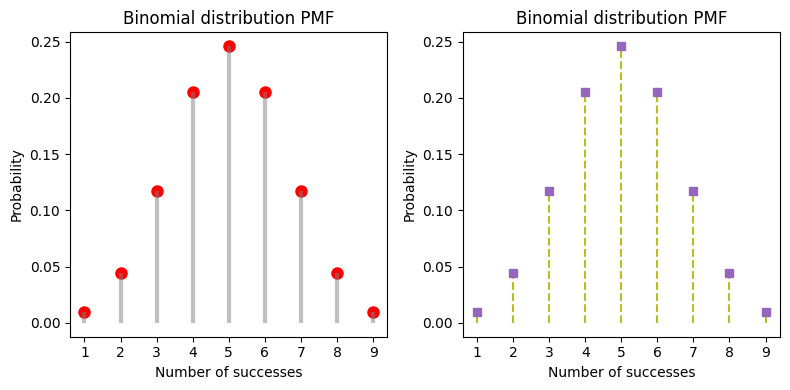
Simulating a clinical trial scenario#
Let’s say we’re conducting a clinical trial for a new drug. We have 30 patients in the trial, and we’re interested in the number of patients who show improvement with the medication, or said differently, what is the chance that 10 or more of the next 30 patients will get better. Based on previous studies, we estimate that the probability of a patient showing improvement is 0.05 (5%). Here’s how we can simulate this scenario 10,000 times.
# Parameters of the binomial distribution
n = 30 # number of patients
p = 0.05 # probability of a patient showing improvement
# Number of trials
num_trials = 10000
# Simulate the trials
trials = binom(n, p).rvs(num_trials, random_state=111) # for reproducibility
# Calculate the mean number of improvements
mean_improvements = np.mean(trials)
print(f"Mean number of improvements in {num_trials} trials: {mean_improvements}")
Mean number of improvements in 10000 trials: 1.5165
trials[:15]
array([2, 0, 1, 2, 1, 0, 0, 1, 1, 1, 5, 1, 0, 2, 2], dtype=int64)
The script returns the array trials of length 10,000 where each element is the number of improvements in a trial, and then calculates the mean number of improvements across all trials.
To calculate the probability of getting exactly 10 improvements out of 30 in a single trial, we can use the Probability Mass Function (PMF) of the binomial distribution. In Python, we can use the binom.pmf function from the scipy.stats module.
Overall this simulation can give us a sense of the variability we might expect in the number of improvements when conducting the clinical trial multiple times. It’s a powerful tool for understanding the potential outcomes and risks associated with the trial.
# Calculate the probability of getting exactly 10 improvements
prob = binom.pmf(10, n, p)
print(f"The probability of getting exactly 10 improvements in a single trial is {prob:.3f}")
The probability of getting exactly 10 improvements in a single trial is 0.000
Or we can simply count the number of trials that resulted in 10 improvements:
# Calculate the frequency of getting exactly 10 improvements
freq = (trials == 10).sum()
print(f"The frequency of getting exactly 10 improvements in {num_trials} trials is {freq}")
The frequency of getting exactly 10 improvements in 10000 trials is 0
Let’s finally plot a histogram to visualize the distribution of improvements.
# Plot the histogram
plt.hist(
trials,
bins=range(n+2),
align='left',
rwidth=0.8,
color='blue',
edgecolor='black',
density=True,)
plt.title('Histogram of improvements in 10,000 clinical trials')
plt.xlabel('Number of improvements')
plt.xticks(np.arange(0, 11, 1))
plt.xlim(-.5, 8.5)
plt.ylabel('Frequency');
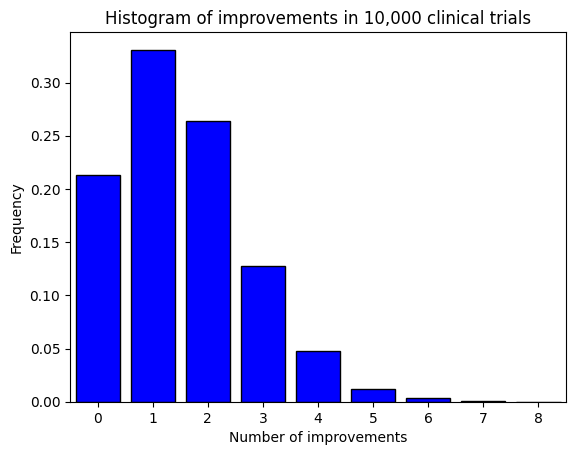
The Democrat voters example#
Let’s calculate the answer for the question of the book: “If 40% of voters are Democrats, what is the chance that a random sample of 600 voters will be at least 45% Democrat?”
# Parameters of the binomial distribution
n = 600 # number of voters in the sample
p = 0.4 # probability of a voter being a Democrat
# Number of successes we're interested in
k = int(0.45 * n) - 1 # subtract 1 because we want at least 45%, not up to 45%
# Calculate the probability of getting at least 45% Democrats
prob = binom.sf(k, n, p)
print(f"The probability of getting at least 45% Democrats in the sample is {prob:.3f}")
The probability of getting at least 45% Democrats in the sample is 0.007
x = np.arange( # linspace not appropriate for non-continuous distributions
binom.ppf(.001, n, p),
binom.ppf(.999, n, p)+1, # include the point at the 99.9th percentile
step=1)
plt.plot(x, binom(n,p).pmf(x))
plt.title('Binomial Distribution PMF')
plt.xlabel('Number of Democrats')
plt.ylabel('Probability');
#plt.vlines(x, 0, binom.pmf(x, n, p), colors='b', lw=5, alpha=.5);
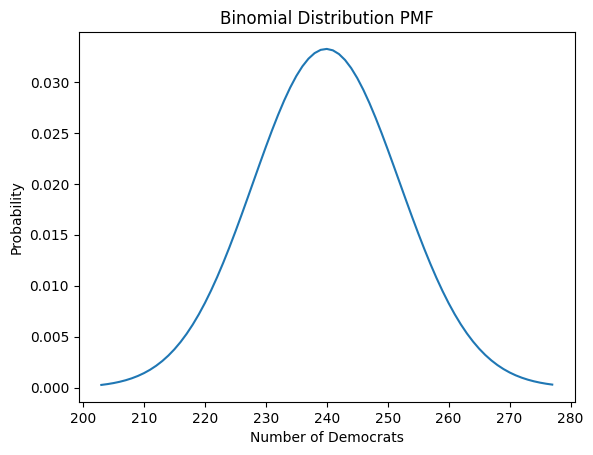
The previous script gives a theoretical calculation based on the binomial distribution, not an empirical result based on random sampling. Let’s try the random sampling approach.
# Parameters of the binomial distribution
n = 600 # number of voters in the sample
p = 0.4 # probability of a voter being a Democrat
# Number of simulations
num_simulations = 10000
# Number of successes we're interested in
k = int(0.45 * n) # at least 45% Democrats
# Simulate the samples
samples = binom(n=n, p=p).rvs(size=num_simulations, random_state=111)
# Calculate the frequency of getting at least k Democrats
freq = np.sum(samples >= k)
# Calculate the empirical probability
empirical_prob = freq / num_simulations
print(f"The empirical probability of getting at least 45% Democrats in the sample is \
{empirical_prob}")
The empirical probability of getting at least 45% Democrats in the sample is 0.0059
# plt.hist(samples, bins=range(n+2), align='left', color='blue', density=True)
# density=True normalizes the histogram
plt.hist(samples, bins=range(n+2), align='left', color='blue')
plt.title('Histogram of Democrats in Simulated Samples')
plt.xlabel('Number of Democrats')
plt.xlim(195, 285)
plt.ylabel('Counts');
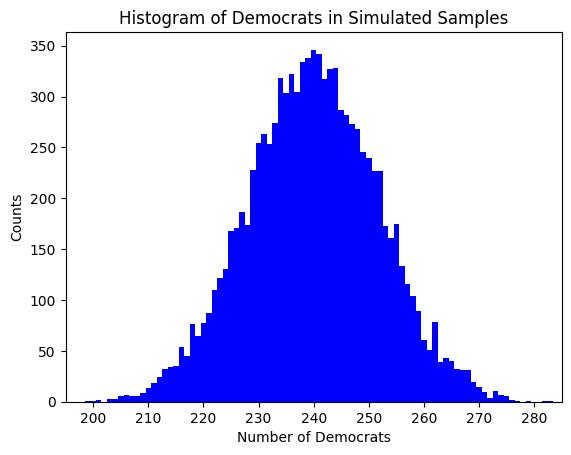
This histogram gives we a visual representation of the distribution of Democrats in the simulated samples. Each bar represents the number of samples that resulted in a certain number of Democrats.
Now, every time we run the script, it generates a new set of random samples from the binomial distribution, which can result in a slightly different distribution each time. This is due to the inherent randomness in the sampling process. However, despite these differences, all the distributions generated will have the same underlying characteristics defined by the binomial distribution with parameters \(n\) (number of trials) and \(p\) (probability of success). In other words, they are all samples from the same population distribution.
Over a large number of simulations, the distribution of the results should converge to the theoretical binomial distribution. This is known as the Law of Large Numbers, which states that as the number of trials increases, the experimental probability (observed proportion in the simulation) gets closer to the theoretical probability (defined by the binomial distribution).
So, while each run of the script may produce a slightly different distribution due to randomness, the overall shape and characteristics of the distribution should remain consistent with the binomial distribution. This is a fundamental concept in statistics and is the basis for techniques such as hypothesis testing and confidence intervals.
Confidence interval#
Free throw success rate#
We will explore the concept of confidence intervals in the context of basket free throws by taking the example on pages 32-33 of the book.
Imagine a basket player who is practicing his free throws. He makes 20 attempts and succeeds in 17 of these. We can consider each free throw as a Bernoulli trial where there are only two possible outcomes - success (the player makes the shot) or failure (the player misses the shot). In this case, the player’s free throw success rate would be the proportion of successful shots, which is 17 out of 20, or 0.85.
np.random.binomial(20, .85)
15
However, this is only the player’s success rate for these 20 shots. If he were to continue shooting, his success rate might be slightly higher or lower than this. This is where confidence intervals come in. A confidence interval gives us a range of values within which we expect the player’s true success rate (for all shots, not just these 20) to lie, with a certain level of confidence.
We will calculate a confidence interval for the player’s free throw success rate based on his performance in these 20 shots. This will give us a better idea of how well we can expect him to perform in the future. We also calculates the 2.5th and 97.5th percentiles of the success rates to get the lower and upper bounds of the 95% confidence interval, and mark the confidence interval on the chart with red dashed lines.
import seaborn as sns # let's use another visualization package
# Parameters of the binomial distribution
n = 20 # denominator: number of free throw attempts
s = 17 # numerator: number of successeful throws
p = s/n # success rate
# Number of simulations
np.random.seed(111) # for reproducibility
num_simulations = 10000
# Simulate the success rates
success_throws = np.random.binomial(n, p, num_simulations)
# Calculate the 95% confidence interval from simulations
ci_lower, ci_upper = np.percentile(success_throws, [2.5, 97.5])
print(f"The 95% confidence interval for the success rate is ({ci_lower}, {ci_upper})")
# Plot the histogram
sns.histplot(
success_throws,
stat='proportion', # also called 'probability'
discrete=True, # default to `binwidth=1` and draw bars centered on the datapoint
color='yellowgreen',
edgecolor='black',)
plt.title('Histogram of simulated successful throws')
plt.xlabel('Number of successes out of 20 throws')
# plt.xticks(np.arange(0, 21))
# plt.xlim(10.5, 20.5)
plt.ylabel('Density')
plt.axvline(ci_lower, color='red', linestyle='--')
plt.axvline(ci_upper, color='red', linestyle='--');
The 95% confidence interval for the success rate is (14.0, 20.0)
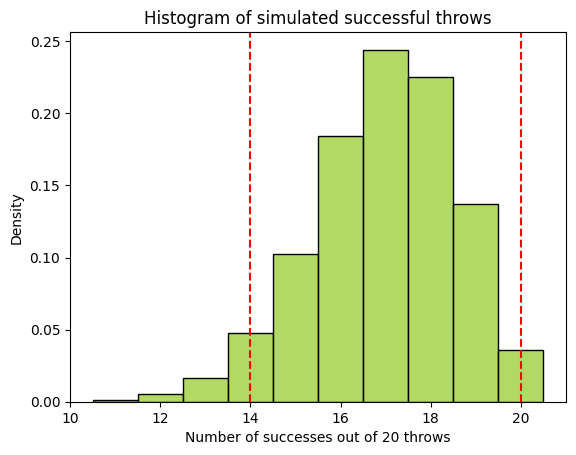
Of note, scipy.stats.binom provides us with the confidence interval with equal areas around the median.
print(f"The 95% confidence interval with equal areas around the median is \
{binom.interval(confidence=.95, n=20, p=17/20)}")
The 95% confidence interval with equal areas around the median is (14.0, 20.0)
The Central Limit Theorem#
The Central Limit Theorem (CLT) states that the distribution of the sum (or average) of a large number of independent, identically distributed variables approaches a normal distribution, regardless of the shape of the original distribution.
In the context of our experiment, if we’re conducting a large number of trials (like 10,000), the distribution of the sample proportions (the number of successes in each trial divided by the number of attempts) will tend to follow a normal distribution. This is due to the CLT.
Therefore, when we calculate the 2.5th and 97.5th percentiles of this distribution (which gives us a 95% confidence interval), it should be close to the theoretical binomial confidence interval, especially when the number of trials is large.
However, it’s important to note that the CLT provides an approximation, and the accuracy of this approximation depends on the number of trials and the true success probability. The approximation is generally better when the number of trials is large and the success probability is not too close to 0 or 1.
Computing the confidence interval#
As explained in the book, we can compute the confidence interval using the modified Wald method by hand as follows:
\(p'=\frac{s + 2}{n + 4}\) where \(s\) is the number of successes, and \(n\) the number of trials
The margin of error is \(W = 2\sqrt{\frac{p' (1 - p')}{n + 4}}\)
Finally, the 95% confidence interval spans from \((p' - W)\) to \((p' + W)\)
p_prime = (s+2)/(n+4) # n=20
W = 2*(p_prime*(1-p_prime)/(n+4))**.5
ci_inf = p_prime - W
ci_sup = p_prime + W
print(f"The 95% confidence interval based on the modified Wald method extends \
\nfrom {100*ci_inf:.2f}% to {100*ci_sup:.2f}% of success")
The 95% confidence interval based on the modified Wald method extends
from 62.59% to 95.75% of success
Programatically, we can use scipy.stats.norm.interval to compute the confidence interval assuming a normal distribution, and statsmodels.stats.proportion to compute the confidence interval for proportions using different methods, including the numerical inversion of the binomial test in scipy.stats (‘binom_test’), and Clopper-Pearson interval based on Beta distribution (‘beta’). We can also find a calculator for confidence interval of a proportion from GraphPad.
from scipy.stats import norm
import statsmodels.stats.proportion as smp
# Calculate the mean and standard deviation of the success rates from the previous simulation
# Later we'll see how to leverage mean and std directly from the theoritical model
mean = np.mean(success_throws)
std_dev = np.std(success_throws)
# Calculate the 95% confidence interval using scipy.stats.norm.interval
ci_lower, ci_upper = norm.interval(0.95, loc=mean, scale=std_dev)
print(f"The 95% confidence interval of successful throws (assuming a normal distribution)\
\nis ({ci_lower:.0f}, {ci_upper:.0f}) out of 20")
# Calculate the 95% CI around the median using scipy.stats.binom.interval
print(f"The 95% confidence interval with equal areas around the median is \
{binom.interval(confidence=.95, n=n, p=p)}")
# Calculate the 95% confidence interval for proportions using statsmodels.stats.proportion
ci_lower, ci_upper = smp.proportion_confint(count=s, nobs=n, alpha=0.05, method='normal')
print(f"The 95% confidence interval for the success rate (using default 'normal')\
\nis ({100*ci_lower:.2f}%, {100*ci_upper:.2f}%)")
ci_lower, ci_upper = smp.proportion_confint(count=s, nobs=n, alpha=0.05, method='binom_test')
print(f"The 95% confidence interval for the success rate (using 'binom_test')\
\nis ({100*ci_lower:.2f}%, {100*ci_upper:.2f}%)")
# An alternative method is Clopper-Pearson (used in GraphPad), called 'beta'
ci_lower, ci_upper = smp.proportion_confint(count=s, nobs=n, alpha=0.05, method='beta')
print(f"The 95% confidence interval for the success rate (using Clopper-Pearson 'beta')\
\nis ({100*ci_lower:.2f}%, {100*ci_upper:.2f}%)")
The 95% confidence interval of successful throws (assuming a normal distribution)
is (14, 20) out of 20
The 95% confidence interval with equal areas around the median is (14.0, 20.0)
The 95% confidence interval for the success rate (using default 'normal')
is (69.35%, 100.00%)
The 95% confidence interval for the success rate (using 'binom_test')
is (62.78%, 95.78%)
The 95% confidence interval for the success rate (using Clopper-Pearson 'beta')
is (62.11%, 96.79%)
Confidence interval of polling#
In the scenario analyzed on pages 33-34, we have conducted a poll on a sample of 100 voters, and 33 of them have indicated that they would vote for one great candidate. This gives a sample proportion of 0.33 (or 33%).
However, this is just the proportion for our sample. If we want to make an inference about the proportion of all voters in the population who will vote for this candidate, we can construct a confidence interval around the sample proportion.
A confidence interval provides a range of values which is likely to contain the population proportion. The width of the confidence interval gives us an idea about how uncertain we are about the unknown population proportion. A wider interval implies more uncertainty.
The actual calculation of the confidence interval can depend on the assumptions we make about the distribution of voters’ preferences. If the sample size is large enough, by the Central Limit Theorem, the sampling distribution of the sample proportion is approximately normally distributed. In this case, we can use methods for constructing confidence intervals based on the normal distribution or resampling/bootstraping.
# Parameters of the binomial distribution
n = 100 # number of voters sampled
s = 33 # 'sucess' count
p = s/n # rate voting for the great candidate
# Number of simulations
num_simulations = 10000
# Simulate the success rates
model = binom(n, p)
voters = model.rvs(num_simulations, random_state=111)
# Calculate the 95% confidence interval
ci_lower, ci_upper = np.percentile(voters, [2.5, 97.5])
print(f"The 95% confidence interval using numpy percentile (bootstrap) is \
({ci_lower}, {ci_upper}) out of 100")
# Calculate the 95% confidence interval using scipy.stats.norm.interval
# ci_lower, ci_upper = norm.interval(0.95, loc=np.mean(voters), scale=np.std(voters))
ci_lower, ci_upper = norm.interval(
0.95,
# Use theoritical distribution
loc=model.mean(),
scale=model.std())
print(f"The 95% confidence interval using scipy norm.interval is \
({ci_lower:.2f}, {ci_upper:.2f}) out of 100")
# Calculate the 95% CI around the median using scipy.stats.binom.interval
print(f"The 95% confidence interval with equal areas around the median is \
{binom.interval(confidence=.95, n=n, p=p)}")
# Calculate the 95% confidence interval for proportions using statsmodels.stats.proportion
ci_lower, ci_upper = smp.proportion_confint(count=s, nobs=n, alpha=0.05, method='normal')
print(f"The 95% confidence interval for the success rate (using default 'normal')\
\nis ({100*ci_lower:.2f}%, {100*ci_upper:.2f}%)")
ci_lower, ci_upper = smp.proportion_confint(count=s, nobs=n, alpha=0.05, method='binom_test')
print(f"The 95% confidence interval for the success rate (using 'binom_test')\
\nis ({100*ci_lower:.2f}%, {100*ci_upper:.2f}%)")
# An alternative method is Clopper-Pearson (used in GraphPad), called 'beta'
ci_lower, ci_upper = smp.proportion_confint(count=s, nobs=n, alpha=0.05, method='beta')
print(f"The 95% confidence interval for the success rate (using Clopper-Pearson 'beta')\
\nis ({100*ci_lower:.2f}%, {100*ci_upper:.2f}%)")
# plot the histogram and a box-plot
f, ax = plt.subplots(1,2, figsize=(8,4))
ax[0].hist(voters)
ax[1].boxplot(voters, vert=False, whis=[5, 95]);
The 95% confidence interval using numpy percentile (bootstrap) is (24.0, 42.0) out of 100
The 95% confidence interval using scipy norm.interval is (23.78, 42.22) out of 100
The 95% confidence interval with equal areas around the median is (24.0, 42.0)
The 95% confidence interval for the success rate (using default 'normal')
is (23.78%, 42.22%)
The 95% confidence interval for the success rate (using 'binom_test')
is (24.42%, 42.97%)
The 95% confidence interval for the success rate (using Clopper-Pearson 'beta')
is (23.92%, 43.12%)
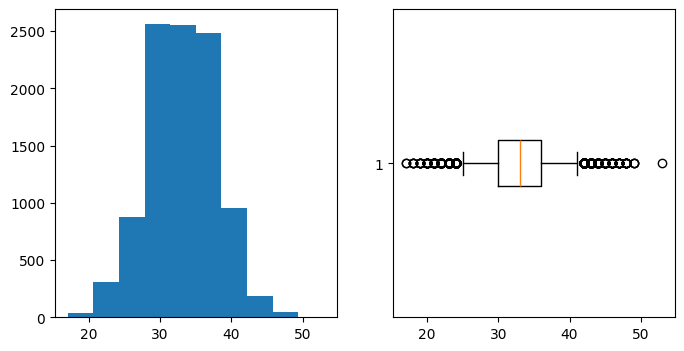
What does 95% confidence really mean?#
Remember, the confidence interval gives a range of plausible values for the population proportion based on the sample data. It does not guarantee that the population proportion is within this range, but it gives a range where the population proportion is likely to fall, with a certain level of confidence (often 95%).
We illustrate that using the example of pages 35-36. The experiment involves a bowl that contains 100 balls in total. Out of these, 25 balls are red and the remaining 75 balls are black. The balls are well mixed to ensure randomness. The process is as follows:
A ball is chosen randomly from the bowl.
The color of the ball is recorded.
The ball is then placed back into the bowl.
The balls are mixed again.
Steps 1-4 are repeated 15 times.
Each time a ball is chosen, it represents a Bernoulli trial since there are only two possible outcomes - the ball is either red or black. The proportion of red balls chosen in these 15 trials is recorded.
This process is then simulated 20 times, each time recording the fraction of red balls chosen. For each simulation, a 95% confidence interval for the proportion of red balls is computed. The aim is to observe that approximately 1 out of 20 of these 95% confidence intervals will not include the true population proportion of red balls (which is 0.25 or 25% in this case).
# Parameters of the binomial distribution
n = 15 # number of trials
s = .25*15 # red balls
p = s/n # success rate
# Number of simulations
num_simulations = 10000
# Simulate the probability rates
model = binom(n=n, p=p)
bowl = model.rvs(size=10000, random_state=111)
# Calculate the 95% confidence interval based on the CLT
ci_lower, ci_upper = np.percentile(bowl, [2.5, 97.5])
print(f"The 95% confidence interval (numpy percentile) is \
({ci_lower:.3f}, {ci_upper:.3f}) out of 15")
# Calculate the 95% confidence interval using scipy.stats.norm.interval
ci_lower, ci_upper = norm.interval(0.95, loc=model.mean(), scale=model.std())
print(f"The 95% confidence interval (scipy norm.interval) is \
({ci_lower:.2f}, {ci_upper:.2f}) out of 15")
The 95% confidence interval (numpy percentile) is (1.000, 7.000) out of 15
The 95% confidence interval (scipy norm.interval) is (0.46, 7.04) out of 15
The statsmodels.stats.proportion.proportion_confint function is used to calculate the confidence interval for a proportion in a way that properly accounts for the binomial distribution, which is discrete. The count parameter of this function represents the number of successes (in this case, the number of red balls drawn), and it must be an integer because we can’t have a fraction of a success in a binomial experiment. It’s either a success or not, hence, it’s a discrete value.
So, in our case, if we’re drawing 15 balls and we know that 25% of them are red, we can’t enter 0.25 * 15 for the count parameter because this would be a fractional number. Instead, we should enter the actual number of red balls drawn in the sample. For example, if we drew 4 red balls out of 15, we would enter 4 for the count parameter.
# Number of successes and trials
count = 4 # number of red balls drawn
nobs = 15 # total number of balls drawn
# Calculate the 95% confidence interval for the proportion
ci_lower, ci_upper = smp.proportion_confint(count, nobs, alpha=0.05, method='binom_test')
print(f"The 95% confidence interval for the proportion of red balls is \
({100*ci_lower:.2f}%, {100*ci_upper:.2f}%)")
The 95% confidence interval for the proportion of red balls is (9.67%, 53.43%)
Let’s simulate the trials, and calculate the confidence intervals for 100 random experiments.
# Parameters of the binomial distribution
n = 15 # number of balls drawn per trial
p = 0.25 # probability of drawing a red ball
# Number of trials
num_trials = 100
# Simulate the trials
red_balls = binom(n, p).rvs(num_trials, random_state=111)
# Calculate the confidence intervals
confidence_intervals = [
smp.proportion_confint(count, n, alpha=0.05, method='binom_test') for count in red_balls]
# Create a figure and a set of subplots
fig, ax = plt.subplots(figsize=(12,5))
# Loop over the data and create error bars with different colors based on the condition
for i, (count, (ci_lower, ci_upper)) in enumerate(zip(red_balls, confidence_intervals)):
color = 'red' if ci_lower > 0.25 or ci_upper < 0.25 else 'black'
ax.errorbar(i, count/n, [[count/n - ci_lower], [ci_upper - count/n]], color=color, fmt='o')
plt.axhline(p, ls='--', lw=3, color='cornflowerblue')
plt.title('Confidence intervals for proportion of red balls')
plt.xlabel('Trial')
plt.xticks([])
plt.xlim(.5, 100.5)
plt.ylabel('Proportion of red balls')
sns.despine();
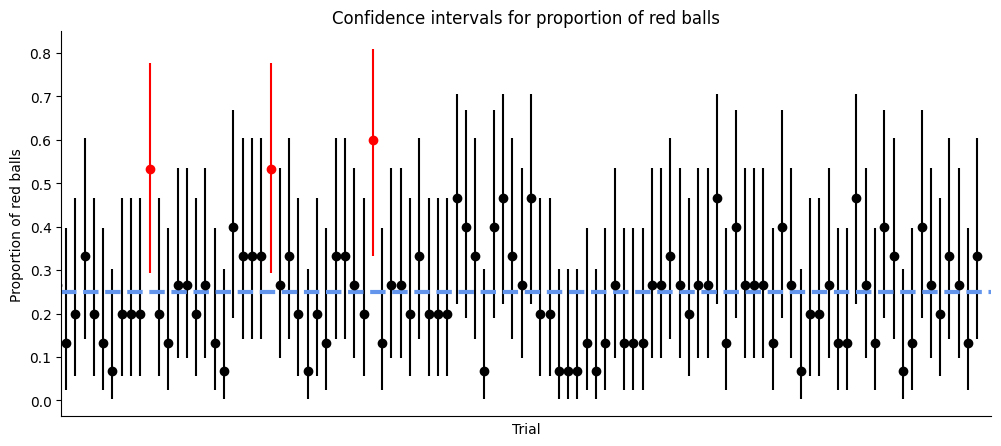
This experiment helps illustrate the concept of confidence intervals and their interpretation. It shows that a 95% confidence interval does not guarantee that the population parameter (in this case, the proportion of red balls) lies within the interval. Rather, it means that if we were to repeat the experiment many times and calculate a confidence interval each time, we would expect about 95% of these intervals to contain the population parameter. Interestingly, Cumming and Maillardet (2006) have shown that the first 95% CI will include the sample means of 83.4% of repeat experiments, due to experimental bias and error.
Conclusion#
Throughout this chapter, we’ve explored various statistical concepts and how to implement them programmatically using Python. We’ve used libraries such as numpy, scipy.stats, statsmodels, and matplotlib to simulate experiments, calculate statistics, and visualize data.
We started with a discussion on binomial distribution and confidence intervals in the context of polling voters and basketball free throws. We then simulated an experiment involving drawing balls from a bowl and calculated confidence intervals for the proportion of red balls drawn.
We learned how to use the binom function from scipy.stats to simulate binomial experiments, and the proportion_confint function from statsmodels.stats.proportion to calculate confidence intervals for proportions. We also discussed how to use numpy for array operations and random number generation. In addition, we explored the Central Limit Theorem and its implications for the approximation of the binomial distribution with the normal distribution.
Overall, this chapter provided a practical, hands-on introduction to some key statistical concepts and how to work with them programmatically in Python. It demonstrated the power of Python and its libraries for statistical analysis and data visualization, and it highlighted the importance of understanding these concepts for interpreting statistical results and making informed decisions based on data.
Cheat sheet#
This cheat sheet provides a quick reference for essential code snippets used in this chapter.
Binomial distribution#
from scipy.stats import binom
# Parameters of the binomial distribution
n = 10 # number of trials
p = 0.5 # probability of succes
# Prepare the distribution
binom_distribution = binom(n=n, p=p)
# Calculate mean, variance (and more), and SD from the distribution
binom_distribution.stats(moments='mv')
binom_distribution.mean()
binom_distribution.std()
PMF Lollipop plot#
import numpy as np
import matplotlib.pyplot as plt
plt.stem(
# central 99.8% of the distribution
x:=np.arange(
binom_distribution.ppf(q=.001), # Percent Point Function
binom_distribution.ppf(q=.999) + 1,
step=1),
binom_distribution.pmf(x),
)
Probabilities#
# Probability Mass Function - P(X=5)
binom_distribution.pmf(k=5)
# Cumulative Distribution Function - P(X<=3)
binom_distribution.cdf(x=3)
# Survival Function - P(X>6) or P(X>=7)
binom_distribution.sf(x=6)
Confidence Interval#
# Parameters of the binomial distribution
numerator = 33 # number of successes
denominator = 100 # number of trials
size = 10000 # number of simulations
# Generate random variates
binom_distribution = binom(n=denominator, p=numerator/denominator)
experiments = binom_distribution.rvs(size=size, random_state=111)
# Modified Wald method
p_prime = (numerator + 2) / (denominator + 4)
W = 2 * (p_prime * (1 - p_prime) / (denominator + 4))**.5
(p_prime - W, p_prime + W)
# Bootstrap 95% percentiles
np.percentile(experiments, [2.5, 97.5])
# 95% CI with equal areas around the median
binom_distribution.interval(confidence=.95)
# `statsmodels.stats.proportion` functions
import statsmodels.stats.proportion as smp
# alternative method='normal' (default) or 'beta'
smp.proportion_confint(
count=numerator,
nobs=denominator,
alpha=0.05,
method='binom_test')
Session Information#
The output below details all packages and version necessary to reproduce the results in this report.
Show code cell source
!python --version
print("-------------")
# List of packages we want to check the version
packages = ['numpy', 'scipy', 'statsmodels', 'matplotlib', 'seaborn']
# Initialize an empty list to store the versions
versions = []
# Loop over the packages
for package in packages:
# Get the version of the package
output = !pip show {package} | findstr "Version"
# If the output is not empty, get the version
if output:
version = output[0].split()[-1]
else:
version = 'Not installed'
# Append the version to the list
versions.append(version)
# Print the versions
for package, version in zip(packages, versions):
print(f'{package}: {version}')
Python 3.12.4
-------------
numpy: 1.26.4
scipy: 1.13.1
statsmodels: 0.14.2
matplotlib: 3.9.0
seaborn: 0.13.2
